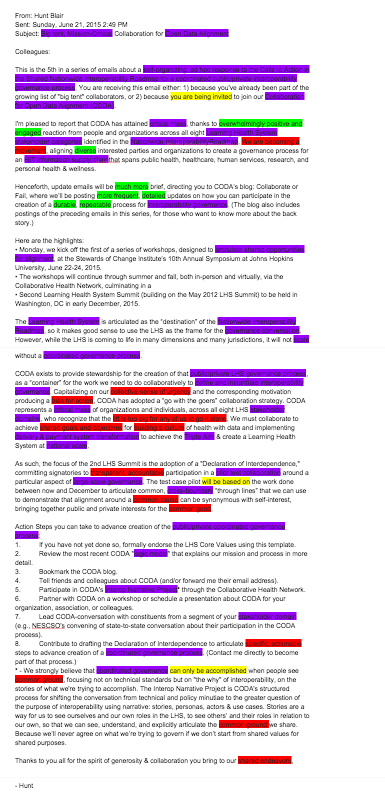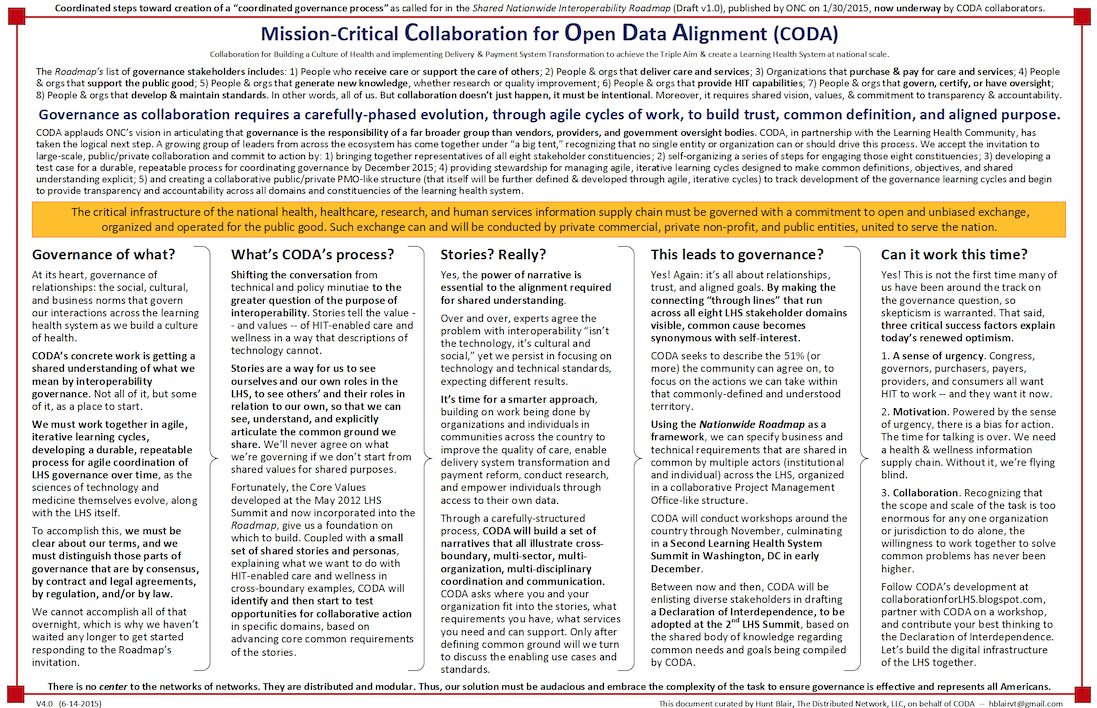Trying to rally the troops? Jargon is not the answer.
 If you were a mad scientist working on a formula for overblown, passive, jargon-ridden prose, you’d combine three powerful bullshitogenic ingredients: government, health care, and information technology. Today we’ll hear from someone who did just that, and revealed how a long immersion in bad writing can overwhelm even the most diligent workers. If you’re stuck in a world like this, I’ll show you how to escape.
If you were a mad scientist working on a formula for overblown, passive, jargon-ridden prose, you’d combine three powerful bullshitogenic ingredients: government, health care, and information technology. Today we’ll hear from someone who did just that, and revealed how a long immersion in bad writing can overwhelm even the most diligent workers. If you’re stuck in a world like this, I’ll show you how to escape.
Hunt Blair is on a mission to realize the government’s Shared Nationwide Interoperability Roadmap, which points the way to how patients and providers will share health information in the future. I was pleased to speak with Hunt, a passionate and articulate advocate for electronic health data and how to make it common and useful. I agree with him that the rules and process around that data will determine the future of health care.
 Getting there is a monumental task. It requires getting people from diverse organizations with diverse viewpoints all working hard together. Hunt is rallying the troops with a series emails that include the most opaque and indigestible writing I’ve ever seen. I’ve slogged through the full text (866 words) and marked the jargon purple, weasel words green, cheerleading red, and passive voice in yellow in the graphic here. I’ll only analyze a few small, toxic samples here.
Getting there is a monumental task. It requires getting people from diverse organizations with diverse viewpoints all working hard together. Hunt is rallying the troops with a series emails that include the most opaque and indigestible writing I’ve ever seen. I’ve slogged through the full text (866 words) and marked the jargon purple, weasel words green, cheerleading red, and passive voice in yellow in the graphic here. I’ll only analyze a few small, toxic samples here.
Here’s how he starts:
Subject: Big tent, Mission-Critical Collaboration for Open Data Alignment
This is the 5th in a series of emails about a self-organizing, ad hoc response to the Calls to Action in the Shared Nationwide Interoperability Roadmap for a coordinated public/private interoperability governance process.
This might as well be a sign that reads “Turn back, go no further!” We’ve got seven jargon words in the subject line and the ever-inviting “5th in a series of emails.” And from talking to Hunt, I understand the importance of a “coordinated public/private interoperability governance process” but surely we could find something more enticing to call it?
There’s also some fun cheerleading in the middle:
Capitalizing on our collective sense of urgency and the corresponding motivation producing a bias for action, CODA has adopted a “go with the goers” collaboration strategy. CODA represents a critical mass of organizations and individuals, across all eight LHS stakeholder domains, who recognize that the lift is too big for any of us to go it alone. We must collaborate to achieve shared goals and objectives for building a culture of health with data and implementing delivery & payment system transformation to achieve the Triple Aim & create a Learning Health System at national scale.
This combination of buzzphrases (“sense of urgency” “bias for action” “lift is too big for any of us to go it alone”), acronyms, and jargon is positively Soviet.
Hunt is trying to do the right thing. He’s started a blog called Collaborate or Die, which is full of the same language. So’s his Linked In page. And when I asked him for a clear description of what he was doing, he shared this one-page summary graphic.
STOP. Please stop. Inflicting this upon readers is wrong.
You cannot attack a complex problem with complex writing. You’re trying to slay a dragon with a styrofoam sword. You will fail.
What should Hunt do? Here are my suggestions on how to rally the troops:
- Hire a writer who understands marketing. If this is how you write, you need help. Find someone who can express themselves clearly. It’s called marketing and positioning, friends, and it’s an actual skill.
- Create powerful, simple words for your concepts. The root of Hunt’s problem is that he uses (and builds on) the impenetrable jargon of his field, thus limiting his collaborators to those who understand health care/IT/government gibberish. Why not call this “building a framework for health data”? We can all understand that. Then build some more language that connects with that.
- Use graphics. I love words. But sometimes a picture works better. In this case, a picture would make things much clearer. If you can’t draw a clear picture, you don’t actually know what you’re talking about. So work on it.
- Create an active mission statement people will actually believe in. This means using the word “we.” Here’s what Hunt wrote (from the graphic above):
The critical infrastructure of the national health, healthcare, research, and human services information supply chain must be governed with a commitment to open and unbiased exchange, organized and operated for the public good. Such exchange can and will be conducted by private commercial, private non-profit, and public entities, united to serve the nation.
No one rallies to a passive-voice mission. Here’s what he could have written:
We will build a framework for health data sharing. Government, healthcare, and research entities will build it together. We will seek out stories about how data-sharing benefits everyone, and expand them into a common framework for America.
- Resist mission creep. All over Hunt’s writing I see the signs that he has expanded his goals to accommodate every possible contributor and scenario. This always leads to wimpy, meaningless results. If you try to make everyone a little happy, you’ll get nowhere.
- Use the right tools to create dialogue. Five long emails are no way to rally the troops. Instead, use a combination of tools. Use Twitter and Facebook to spread the word and an email list to direct people toward resources and call for action. Use a blog for more detailed content and host resources on a website. These tools, used together, can create dialogue, not just fling huge indigestible chunks of prose at people
- And finally: write everything shorter. Everything Hunt wrote should be one-third the length. The discipline of writing shorter makes you think more clearly.
Photo: By Dickenson V. Alley, photographer, Century Magazine, via Wikimedia Commons

I sent a comment about jargonism to someone requesting my Link on LinkeIn. I never heard back. Seems they are still teaching this junk in business school.
As I said to Josh when we spoke yesterday, I am grateful our paths have crossed. He’s right that the intersection of health care, information technology, and government is about as deep in the jargon swamp as a person could go. The irony is that folks *inside* the swamp consistently have nice things to say about my writing being generally more clear than the average government HIT bureaucract. Thanks for all of the excellent advice Josh. I look forward to sharing a new and improved approach to this outreach communication that is more accessible to those beyond the verbal swamp of Health IT and interoperability governance.
I have a massive headache after reading this… where can I get a comprehensive non-steroidal anti-inflammatory drug (NSAID) that is analgesic and antipyretic in the furtherance of the shared mission of collaborative and open dialogue pain relief with synergies for total body relief?
In other words, aspirin.
You’ll have to visit your local health products retailer and to purchase the over-the-counter (OTC) analgesic. Use as directed.
Just one point of disagreement in your analysis/recommendation… “resist mission creep”. I’ve been at this for over a decade and it’s the tangential special interest that you exclude in the beginning, thinking “we’ll come back to that later” that jumps up and derails everything you’ve worked on for months and months. In other words, trying “to make everyone a little happy” turns out to be essential in a space where so many have the real ability to undermine your effort if you don’t at least try to engage them and address their biggest concerns. Most specifically to the current health information exchange environment – mental health, substance abuse, HIV/AIDS, and other parts of the healthcare ecosystem that have special laws, taboos, stigmas, etc.
This is a fascinating question, David, and could be the topic of a whole book.
If you narrow the mission, you are more likely to get supporters on board — but you may run afoul of the other elements that you describe.
If you broaden the mission to include every possible element, it’s very hard to get people excited and the language gets muddy.
The “How big, when” question is central. There is no simple answer.
Thanks Josh. Yep – as Mr. Mencken told us in slightly different words almost 100 years ago, beware oversimplification… still, I think clear (or clearer) language is possible even when the effort is complicated. I find that linguistic obfuscation is more often a sign of an unwillingness to take on/fess up to real motives (turf protection, fear of change or the unknown, political correctness, etc).